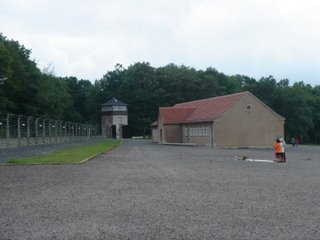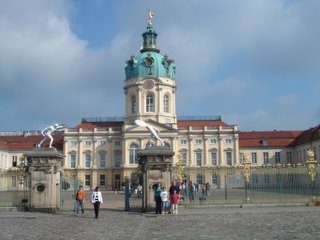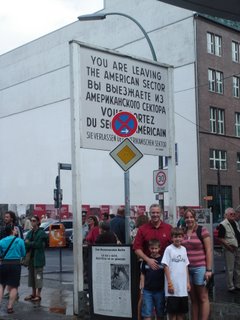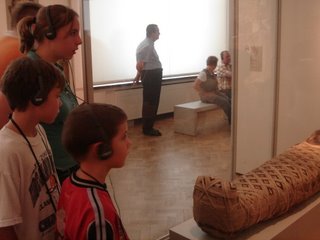Celtic Way
It was Saturday, the last weekend before the kids started school. What should we do? Suggestions included - nap, play computer, play Leggos. No - let's get outside - let's hike. We had heard that if you take a different trail, one that branches from Philosopher's Way, you can find some cool ruins. And we had seen some things from Konigstuhl on the south side of the river. So we set off with our water bottles, hiking shoes and rain jackets to explore. What a great day! It was about a 7 mile hike (if my pedometer is close to accurate) - half of that was straight up - but it was worth it!

The first thing we came across was a tower, built in the early 1900's. We climbed it to find some amazing views of Heidelberg.

We kept going, not knowing what we might find. The hike itself was beautiful - through the forest. The path was wide and well-maintained but went up and up and up. We met many others since hiking on the weekends seems to be a favorite German pastime.

The next thing we came across was the ruins of an old monastery, Stephanskloster, built in 1090. We climbed the tower to see Heidelberg from even higher up (can you see the kids at the top of the tower?) and explored the old ruins.





A view of Heidelberg from Stephanskloster. Remember we started out down by the river and at this point still have some climbing to do! You can see Konigstuhl at the top of the mountain and the clearing in the trees for the old train that takes people up to Konigstuhl.
We continued to climb and the things we stumbled upon were more interesting as we ascended.
We passed by a restaurant. A sign said it was built in the early 1900's. Just around the corner we saw a large brick structure. We turned off the path to it. It was a huge outdoor theater. We then remembered that our relocation agent had mentioned this. It was built by the Third Reich as a place to hold political propaganda rallies. We entered through the door that led to the stage and the seats lay spread out before us.

Here we are standing on the stage. The entrance to the stage from the back is just to the left of Ellen. The orange sign says it was built by the Third Reich in the mid 1930's. This place echoed with voices from the past. It did not take much imagination to visualize this place in 1936.
 I am on the stage and the rest of the family is climbing the steps that run through the center of the seats. Signs elsewhere indicated that this theater had seating for 8,000 and standing room for another 5,000. Apparently the SS would march, in step, down the sides (you can just see these stairways on the side isles of the seats) and their steps would echo in rhythm. They would continue on marcingh up to the steps on the sides of the stage and form a ring from on top of the stage, down the steps. For evening rallies there were massive spotlights placed on the sides and the stage.
I am on the stage and the rest of the family is climbing the steps that run through the center of the seats. Signs elsewhere indicated that this theater had seating for 8,000 and standing room for another 5,000. Apparently the SS would march, in step, down the sides (you can just see these stairways on the side isles of the seats) and their steps would echo in rhythm. They would continue on marcingh up to the steps on the sides of the stage and form a ring from on top of the stage, down the steps. For evening rallies there were massive spotlights placed on the sides and the stage.
Here is a view of the stage from the seats. You can see how massive it is, the steps leading from both sides to the top of the stage and the flag poles in the center.

The place was obviously abandoned. It really could be a beautiful summer theater but there is still too much emotion, guilt and disagreement about what to do with structures like this so it just sits empty and weeds grow.
We kept hiking. Our goal was something marked on the map that looked like the remains of an old church. We were close.

We ended our climb at Klosterruine St Michael, the ruins of another old monastery. This one was larger and more elaborate than the Stephanskloster. We climbed towers and explored the various rooms. Signs indicated what each room was used for by the monks of St Michael.


The grave of someone who died in 1070!
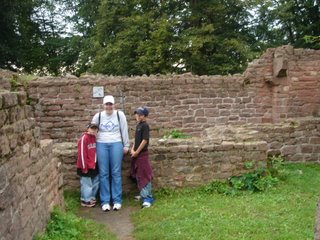
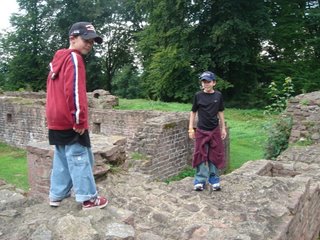
The conversation at this point went something like this...
Can I jump Mom, can I? Dad did.
Do not break something. I am not carrying either one of you up the 50 steps to our front door!

All bones still intact!

A view from the Kloster tower.
Can you see Ellen and Daniel peeking from the top of the second tower?
This is a view of much of the Kloster ruins from the top of the tallest of the two towers.
On our way back home we stopped at the restaurant near the outdoor theater, had something to drink and laughed and laughed. It was such a nice day and a perfect way to spend the Saturday before school started!
Some views from our way back down...



You can see our house in this one. I'm not going to point it out on the world wide web for just anyone to see but if you are interested, call or email and I'll try to describe it so you can pick it out!



 Nestled in the woods, overlooking the peaceful, rolling German countryside is Buchenwald. It seems a location more appropriate for a children's summer camp or a family retreat/resort than the site of a former concentration camp in which torture and mass murder took place.
Nestled in the woods, overlooking the peaceful, rolling German countryside is Buchenwald. It seems a location more appropriate for a children's summer camp or a family retreat/resort than the site of a former concentration camp in which torture and mass murder took place.




